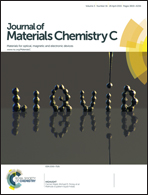Revealing the role of cationic displacement in potassium–sodium niobate lead-free piezoceramics by adding W6+ ions†
Abstract
The effect of the structural modifications induced by the replacement of the B sites with W6+ ions in (K0.44Na0.52Li0.04)[(Nb0.86Ta0.10Sb0.04)1−xW5x/6]O3 lead free ceramics is investigated. Here we show the coexistence between a tetragonal symmetry (T) and an orthorhombic symmetry (O) in the perovskite structure, which is tuned by varying the doping level. In addition, this polymorphic behaviour is accompanied by the appearance of a secondary phase, which can be detected through XRD and Raman results. A correlation between the presence of both structural features and the W6+ content has been evaluated, and therefore this lead free system reveals a transition from a normal ferroelectric to a ‘relaxor-like’ ferroelectric due to the cation disorder in the perovskite-structure in doped samples. A large diffusivity value (γ) has been attained when the x value reached 0.05 owing to the involved O–T polymorphic phase, as well as due to the appearance of a secondary phase. The experimental proof makes clear that the role of the secondary phase is to capture the alkali ions of the (KNa)NbO3-based system, provoking a cation disorder in the perovskite-structure matrix. The significance of this work lies in evaluating whether such a material can benefit the understanding of (KNa)NbO3-based ceramics and the expansion of their application range.


 Please wait while we load your content...
Please wait while we load your content...